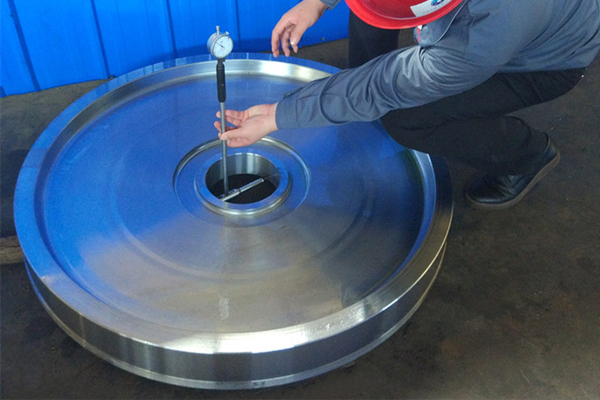Appearance quality inspection is generally a non-destructive inspection, usually with the naked eye or low magnifying glass inspection, if necessary, also use non-destructive inspection method.
The inspection methods of internal quality of heavy forgings can be summarized as: macroscopic organization inspection, microscopic organization inspection, mechanical properties inspection, chemical composition analysis and non-destructive testing.
Macroscopic microstructure test is a kind of test to observe and analyze the low-power microstructure characteristics of forging by visual or low-power magnifying glass. The commonly used methods for the macroscopic structure inspection of forgings are low-power corrosion method (including thermal corrosion, cold corrosion and electrolytic corrosion method), fracture test and sulfur printing method.
Microstructure inspection rule is to use light microscope to check the microstructure of forgings of various materials. The inspection items generally include intrinsic grain size, or grain size at specified temperature, i.e. actual grain size, non-metallic inclusion, microstructure such as decarburization layer, eutectic carbide inhomogeneity, overheat, overburn and other required microstructure, etc.
Mechanical properties and process performance inspection is to have been the final heat treatment of the forgings and test pieces processed into a specified sample after the use of tensile testing machine, impact testing machine, endurance testing machine, fatigue testing machine, hardness tester and other instruments to determine the mechanical properties and process performance values.
Chemical composition testing is generally the use of chemical analysis or spectral analysis of forging components analysis and testing, with the development of science and technology, both chemical analysis and spectral analysis of its analysis means have made progress. For spectral analysis, now is not simply using spectral method and spectroscopic method to carry out component analysis, the emergence of the photoelectric spectrometer not only fast analysis, but also greatly improve the accuracy, and the emergence of plasma photoelectric spectrometer has greatly improved the analysis accuracy, its analysis accuracy can reach 10-6 level, This method is very effective for the analysis of trace harmful impurities such As Pb, As, Sn, Sb, Bi in superalloy forgings.
Said above, the method of test, macroscopic organization, and composition and microstructure test or performance or method, all belong to the destructive testing method, for some heavy forgings of the destructive methods cannot completely adapt to the requirement of quality inspection, on the one hand, this is because it is not the economy, on the other hand is mainly in order to avoid the one-sidedness of destructive testing. The development of NDT technology provides more advanced and perfect means for forging quality inspection.
Nondestructive testing methods for forging quality inspection are generally: magnetic powder inspection method, penetration inspection method, eddy current inspection method, ultrasonic inspection method.
Magnetic particle inspection method is widely used to inspect surface or near surface defects of ferromagnetic metal or alloy forgings, such as cracks, wrinkles, white spots, non-metallic inclusions, delamination, folding, carbide or ferritic bands, etc. This method is only suitable for the inspection of ferromagnetic forgings, but not for the forging made of austenitic steel.
Penetrant inspection method can not only check the magnetic material forgings, but also check the surface defects of non-ferromagnetic material forgings, such as cracks, looseness, folding, etc. Generally, it is only used to check the surface defects of non-ferromagnetic material forgings, and can not find hidden defects below the surface. Eddy current testing is used to check surface or near surface defects of conductive materials.
Ultrasonic inspection method is used to check internal defects of forgings such as shrinkage cavity, white spot, core crack, slag inclusion, etc. Although this method is convenient, fast and economical, it is difficult to accurately determine the nature of defects.
Post time: Nov-17-2021

